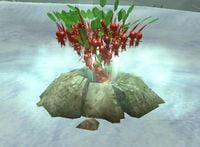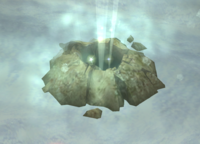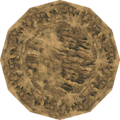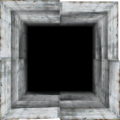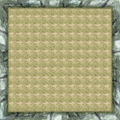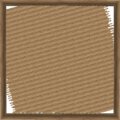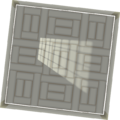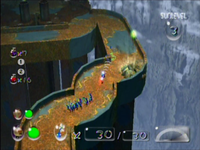Cave
Caves are the underground areas in Pikmin 2, of which 14 exist in all. Although there are several overground areas, most treasures are found in caves, so most of the time playing the game is spent down them.
The time of day does not pass while the player is in a cave, and their floors are generated randomly each time, but follow a specific layout scheme. According to earlier versions of the game, this is because the space-time continuum was warped due to the cave's geomagnetic radiation field.[1] The final version's instruction manual simplifies this and simply calls it "a powerful magnetic field".[2][3]
Caves are entered though holes. To enter one, the player must press ![]() /
/ ![]() while near it. If the other leader is alive, it'll instantly join the party, regardless of distance. Any Pikmin under the current leader's control will jump down with them, and any that are idle, working, or on an idle leader's group will return safely to their Onions. Once the player enters a cave, there is no way to increase Pikmin population save for Bulbmin and/or Queen Candypop Buds. It is not possible to enter a cave without Pikmin.
while near it. If the other leader is alive, it'll instantly join the party, regardless of distance. Any Pikmin under the current leader's control will jump down with them, and any that are idle, working, or on an idle leader's group will return safely to their Onions. Once the player enters a cave, there is no way to increase Pikmin population save for Bulbmin and/or Queen Candypop Buds. It is not possible to enter a cave without Pikmin.
Most objects respawn between visits to the same cave, including enemies. Treasures will not reappear once collected, and some Candypop Buds that have a maximum Pikmin requirement will also not show up.
Inside a cave, if both leaders lose all their health or all Pikmin die, the research pod will cancel the expedition, losing the collected treasures in the process, and then bring them to the overworld. A mission can also be aborted manually by using the pause menu.
The music in caves is significantly more minimal than the music in outside areas, and is partially randomly generated following specific parameters, like the terrain.
Stages in Challenge Mode and 2-Player Battle also take place in caves, but this article focuses on the caves in Story Mode.
The other Pikmin games do not have caves like the ones in Pikmin 2, but have underground locations regardless. Pikmin has The Forest Navel, Pikmin 3 has underground sections within its main areas, and Hey! Pikmin has some cave-themed levels.
List of caves
Sublevels
Each cave is divided into several sublevels. Each sublevel consists of a small area, that gets randomly generated every time it is entered, and will usually have at least one treasure and a few enemies. The shortest cave – Emergence Cave – has two sublevels and the longest – Hole of Heroes – has fifteen.
When a cave is entered, the player will land in its first sublevel, and will be able to proceed through that cave's sublevels in order through the use of holes. When, ![]() /
/ ![]() is pressed near a hole, all Pikmin and live leaders will jump down the hole, landing in the next sublevel. Planted Pikmin will remain in the same sublevel and be lost forever. Some sublevels have geysers that allow the player to safely leave a cave from that sublevel.
is pressed near a hole, all Pikmin and live leaders will jump down the hole, landing in the next sublevel. Planted Pikmin will remain in the same sublevel and be lost forever. Some sublevels have geysers that allow the player to safely leave a cave from that sublevel.
Every time a sublevel is entered, the game is saved, so if the player turns the game off and then back on again, they will start in the same sublevel, but it will be generated randomly again.
Sublevels can be roughly categorized into three types:
Normal levels usually have a few harmful enemies, and sometimes don't have any treasure.
Rest levels either lack enemies or only have harmless enemies (exceptions being Doodlebugs and Bulbmin). Rest levels have Pikmin-supporting items, such as nectar, ultra-bitter spray, ultra-spicy spray, or Candypop Buds. These levels usually lack treasures, and feature special ambient music. Most rest levels also have a geyser available, so the player can return to the surface if they have a low number of Pikmin.
Boss levels contain one or more large bosses, are usually the final level of a cave. The only cave without a boss level is the Emergence Cave, and the one with the most is the Hole of Heroes. When the boss is defeated, it often drops an upgrade for the leaders' space suits or ship.
Hole
To enter a cave, the leaders and Pikmin must dive into a hole. To go from one sublevel to the next, they must also go down a similar hole.
The holes are round, rocky mounds, with a small hole in them. On the cave entrance hole, if the cave has uncollected treasure, wisps of steam will come out, and the screen will become foggy when the hole is approached. Inside a cave, the hole to a next sublevel will always contain steam, but will not fog the screen.
To enter a hole, the player must simply press ![]() /
/ ![]() when their leader is close to it, then confirm this action in a dialog box.
when their leader is close to it, then confirm this action in a dialog box.
Floor designs
Even though most sublevels are randomly generated, there are consistent themes shared between them. The following is a list of themes used in the game, based on what the units are called in the game's files.
- Concrete
- This design features plants, sandy floors, and concrete walls, with concrete floors sometimes as well, alongside blue rusty pipes at times. This design resembles a basement house foundation and is most likely meant to be one. Eggs and bomb-rocks will occasionally fall from the cave ceiling.
- Garden
- This type of design appears as if the party is outside, in a garden, walled in by small rocks and wood chips. These types of sublevels always have harmful enemies in them, save Mitites, and are popular in caves such as the Snagret Hole and in Challenge Mode. The second to last level in Challenge mode, the Sniper Room, is the only nighttime garden level.
- Metal
- This design has metal floors and low walls, making it possible to throw Pikmin, and ward some enemies, out of bounds. It frequently contains Careening Dirigibugs, Gatling Groinks, or Lithopods, with bomb-rocks appearing on occasion. The first area with a floor like this is the first sublevel of the White Flower Garden.
- Snow
- A common sublevel design in the Valley of Repose, these sublevels have floors blanketed with snow, and have stone – and occasionally brick – walls. The floors are commonly littered with dying Figworts. Hairy Bulborbs and Snow Bulborbs are often present here.
- Soil
- This theme represents a very basic type of cave, with soil floors and stone walls.
- Toybox
- These sublevel designs are in caves such as Glutton's Kitchen and the Dream Den. These levels are often filled with giant toys and treasures that are used for food, entertainment, and office supplies. The borders of the sublevels are smaller toys that Pikmin and enemies can cross, but not leaders, similar to the garden theme. They sometimes can be covered with a large carpet or wood flooring that stretches for the entirety of the floor.
- Tiles
- Bath tiles cover nearly the whole sub-level, and many hazards are found on these types of design, mostly water. Wogpoles will sometimes fall from the cave ceiling.
Backgrounds
Some caves have a background (also called a "skybox", or "VRBOX", as they're known internally), as a wall and/or bottom way off in the distance. Because they're so far away, it may be hard to see them over the fog and lighting. Designs that are meant to give off the idea that the leaders and Pikmin are enclosed in a burrow do not have a background, but other sublevels normally do. There can be any sort of sublevel theme and background combination.
Generation
When a sublevel is entered, the game generates it randomly; it starts by building random terrain, and then populates it with random objects.
Layout
A sublevel's terrain is composed of several cave units stitched together. Each unit can be a dead end, a corridor, or a room, and has some spots where objects can spawn; each spot contains data about the amount and type of object that can spawn there. In each sublevel's configuration, there is data about which cave units it is allowed to use, and data about how the dead ends, corridors, and rooms should work in terms of quantities. The game then uses this information to randomly create and connect cave units.
Objects
Each sublevel's configuration also has information about what objects to spawn. Entries listed in this information specify what type they are, what object to spawn, a minimum amount, a random filler weight, spawn location, and some other properties. Depending on these properties, different entries are processed differently by the game. With this in mind, entries can be thought of as belonging to one of five different "categories". As a general rule, the "main" category contains enemies, the "decorative" category contains plants, the "treasure" category contains loose treasures, the "gate" category contains gates, and the "dead end" category contains objects specifically meant to appear in dead ends.
On the wiki, each sublevel section in a cave's article contains a basic list of objects that can spawn, as well as their amounts. It also contains a more detailed list that explains what objects the game wants to spawn, in what order, and under what details. These lists reflect the sublevel's data in the game files. Though the basic list can be changed to better document what really happens in-game, the detailed list always reflects what the sublevel's data says. In the detailed list, the ID of each entry is not something recognized by the game, but exists to make the list easier to understand.
Procedure
After generating the sublevel's layout, the game follows a complex process to spawn objects in it. The following is an outline of this process:[4]
- Decide how many objects to spawn of the "main" category.
- This process is split into four sub-categories, which reflect the entry's spawn type.
- For each sub-category, respect the minimum amounts first. Then, without going beyond the "main" category object limit defined in the sublevel, add some random filler amounts, if there is any entry with random filler weight.
- Spawn the "main" objects in the amounts decided.
- For each sub-category, spawn the minimum amounts first. Then spawn filler objects (if any) picked at random.
- Spawn the minimum amount of objects of the "decorative" category.
- Spawn the minimum amount of objects of the "treasure" category.
- Possibly spawn more picked at random from the "treasure" category.
- Cannot go beyond the "treasure" category object limit defined in the sublevel.
- Caves in Story Mode don't make use of this since every treasure is fixed.
- Spawn the minimum amount of objects of the "dead end" category.
- Possibly spawn more picked at random from the "dead end" category.
- This happens until there are no more dead ends where objects can be placed in.
- Spawn gates picked at random from the "gate" category.
- Cannot go beyond the "gate" category object limit defined in the sublevel.
Missing objects
Because the sublevel generation doesn't use many fixed numbers, and instead opts to use statistics and randomness to generate diverse sublevels, the game can create a sublevel where some objects in its generation data do not spawn. Sometimes an object has a minimum amount of 0, and as luck would have it, it was never chosen when filling out objects at random. At times however, a sublevel may physically be unable to accommodate some of the intended cave units or objects. For example: Frontier Cavern sublevel 4 wants to spawn a Violet Candypop Bud (in a dead end). In one attempt, the generated sublevel has 4 dead ends, so both treasures, the hole, and the Violet Candypop Bud appear in dead ends. But in a different attempt, the game generates a sublevel with 3 dead ends – only the treasures and hole will have a spot, and the Violet Candypop Bud will not show up. This happens often with decorative objects, but can, in rare cases, happen with important objects. Players should be wary about this possibility, and if they find an important item is missing, they can reset the console and try for another sublevel layout.
Scenarios that can make an object not appear include:
- There aren't enough cave units of a given type to fit all objects that want to go in these units.
- There aren't enough spawn points of a given type in the entire sublevel to fit all objects that want to use them.
- The object spawns out of bounds (spawn points randomly offset the spawned objects by an amount).
Note that when the sublevel has finished generating, the game may purposely delete some objects for gameplay reasons. This happens to treasures in Story Mode that have already been collected, and Candypop Buds that do not meet the maximum Pikmin requirement.
Oddities
Cave entrance leader mixup
When entering the first sublevel of a cave, the game may or may not switch the player's active leader. This does not happen when the player goes from one sublevel to the next, making it mysterious as to why the leader changes seemingly randomly when going to the first sublevel.
In reality, this happens because of a simple glitch. In order to decide what leader to turn active whenever a sublevel is entered (be it the first or not), the game reads a variable in memory. This variable is also saved onto the save game data and loaded from it. It is set whenever the player goes from one sublevel to the next, which explains why, when the next sublevel is loaded, the game selects the correct leader. However, this variable never gets set when the cave itself is entered. This means that when the first sublevel is finished loading, the game reads the variable, and uses an outdated value, last updated when a sublevel hole was entered. This glitch was not fixed for the New Play Control! rerelease.
It can also be noted that Challenge Mode uses a different behavior, without a glitch, and that the default value of the variable is 0, meaning that at the start of the game, before the player goes from one sublevel to the next, the game will make Olimar the active leader when entering a cave.
Hole entrance grunt mixup
When entering a cave or sublevel hole, each leader grunts as he jumps. However, the first leader to jump will always make Olimar's sound effect, and the one behind will always make Louie's, regardless of the existing leaders and their order. The only exception is if the second leader is fallen, at which point only the first leader will grunt, still with Olimar's voice.
Technical discrepancies
Even though the cave and sublevel information is present in human-readable format within the game's files, some of their settings appear to make no sense, as the values in the files don't match up to what happens in-game. The following assumed discrepancies have been noted:
- Property {f013} (隠し床, meaning "Hidden floor") of a sublevel indicates whether there's ground under the cave units or if it should be simulated. This is due to the fact that toybox and garden levels' units do not contain ground. However, sublevel 3 of Snagret Hole has this value set to 1 as well, despite the fact that soil-type units always have a ground.
- Sublevel 8 of the Dream Den, sublevels 1 and 2 of the Hot House and sublevels 1, 2, 4, 5, 6 and 7 of the Collector's Room all have their property {f00A} (VRBOX, the "skybox" model) set to "vrbox". Both sublevels of the Green Hole have that property set to "f010". Both of these values are invalid, and the game defaults to having no "skybox".
- In addition, the folder that contains the models for the skyboxes,
/user/Kando/map/vrbox/also contains a file for a "meck" skybox,meck.szs. This skybox is not used in the game, and it contains no model or any other file, just an empty folder.
- In addition, the folder that contains the models for the skyboxes,
- The final sublevels of the Subterranean Complex, the Hole of Beasts and the Bulblax Kingdom all have property {f010} (階段を壊す岩で隠す(0=オフ 1=オン)) set to 1. This property decides whether the hole to the next sublevel should be clogged or not. The oddity here is that the final sublevel does not have a hole.
- The final sublevels in the Cave of Pain, Red Chasm, Collector's Room and the Breeding Ground all have property {f007} (帰還噴水(1=あり)) set to 0. This property decides whether a level contains an escape geyser or not. Naturally, all final sublevels contain one in-game, so the fact that these sublevels have that property set to 0 is a mystery.
Glitches
|
The following article or section is in need of assistance from someone who plays Pikmin 2. |
- Cave hole glitch: It is possible for a leader to end up inside the cave hole's geometry, if he's placed on the hole's spawning point before it spawns.
- Cave death count glitch: If a Pikmin is suffering from a hazard and the player chooses to go to the next sublevel, the Pikmin will still have the suffering animation when jumping down the hole. If they made that last cry, they will nevertheless be alive on the next sublevel, but the total Pikmin lost count will increase.
- Fake Pikmin extinction: By entering a cave and dismissing at the same time, the game will let the player enter the cave with no Pikmin. It then instantly announces a Pikmin extinction.
- There is a glitch that can happen when proceeding to the next sublevel. In the animation where everybody jumps into the hole, some Pikmin may appear idle and won't jump in. Thankfully, these Pikmin that don't jump in will appear on the next sublevel.
Trivia
- Leaving a cave will always make the game switch to Captain Olimar, regardless of whatever leader the player had active before leaving.
- In an earlier version of Pikmin 2, the player could leave caves with half of the collected treasure if they leave through the pause menu. However, all Pikmin would be lost in doing so.[5]
- The fanfare that plays when jumping into the first sublevel of a cave is played again on organ during the fanfare that plays when a deeper sublevel is entered.
- On the Subterranean Complex's third sublevel, and possibly similar levels too, it is possible for the sublevel's hole to spawn on the zigzagging path instead of dead end or somewhere in the open. Since this place is so tight, it spawns a bit on the edge, and makes it possible for leaders or Pikmin to climb up the hole's mound and fall off the stage.[6]
- All story mode caves in Pikmin 2, besides the caves in the Wistful Wild, have some hint of some part of their contents as background scenery nearby. Examples of this would be the concrete block near the Citadel of Spiders (hinting towards the concrete theme), the ceramic tiling near the Frontier Cavern (hinting towards the brick wall designs) and the Shower Room being enclosed in a tiled tub (hinting towards the tile theme used in said cave).
- In "dirt"-styled sublevels, it is possible to see buried treasure through the floor, in some angles.[7]
See also
References
- ^ “A geomagnetic radiation field underground must have warped the space-time continuum. / Even my record of the terrain has been erased.”, Proto:Pikmin 2/Cutscene Text on The Cutting Room Floor
- ^ “Because of a powerful magnetic field deep under the surface, time does not pass underground.” – Explanation in page 25 of the manual
- ^ “The powerful magnetic field between the surface and underground can have peculiar, unexpected results. You can't rely merely on your memory, as familiar areas can often appear foreign.” – Explanation in page 26 of the manual
- ^ Cave spawning on Pikmin Technical Knowledge Base, retrieved on January 27th, 2021
- ^ “Escape without your Pikmin? (Retain 1/2 of treasure found.)”, Pikmin 2/Early English Script on The Cutting Room Floor
- ^ YouTube video of a hole close to the edge (at 56:42)
- ^ Post on reddit, published on May 22nd, 2021, retrieved on May 3rd, 2022
|
This page is currently pending deletion. Reason: |
#REDIRECT Template:P2 caves
